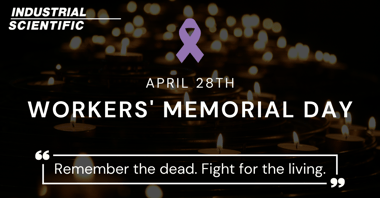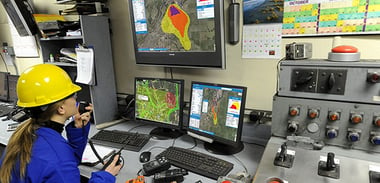As we observe Workers' Memorial Day this April 28th, we take a moment to honor and commemorate those who have lost their lives or been affected by work-related injuries and illnesses. At Industrial Scientific, we hold this day close to our hearts because it aligns with our core mission of preserving human life—on, above, and below the Earth.
Every year, Workers’ Memorial Day is a time for us to reflect on our history and renew our commitment to fight against death on the job. “The impact that we’re striving to deliver can’t be a subsequent generation’s responsibility, it must be our responsibility,” says Parker Burke, President of Industrial Scientific. That is why Our Vision, to eliminate death on the job by the year 2050, is so tangible. Workplace deaths and injuries are unacceptable, and it is our collective responsibility to continue advancing towards a safer future for everyone.
Let's briefly delve into the evolution of gas detection to better understand the progress we've made and the challenges that lie ahead in our mission to ensure workplace safety.
Our History
Since its founding, Industrial Scientific has been on the forefront of gas detection and safety innovations. Below are three major innovations that have changed workplace safety around the world.
Personal Battery-Powered Gas Detector Replaces Flame Safety Lamp
The first gas detectors were far from the advanced technology that is available today. Underground in the darkness of coal mines, workers depended on flame safety lamps to alert them to the presence of methane. The flame, encased by wire gauze to absorb the heat and prevent explosion, was lit in fresh air so that changes in height indicated shifting gas levels. The lamps allowed miners to detect the gas before it reached dangerous levels, but they were not always reliable and led to explosions when not used properly.
In 1981, Industrial Scientific, then a division of National Mine Service Company, crossed the first gas detection frontier by developing a personal, battery-powered gas monitor. This invention transformed the way workers detect explosive gas and allowed them to move away from relying on flame safety lamps.
iNet® Exchange Automates Maintenance
In the late 90s, our team found a more accessible way for companies to keep workers safe: automatic gas monitor maintenance. Gas monitors are a crucial part of keeping workers safe on the job, but they cannot perform at their best without regular care like calibrations, bump tests, and repairs. By automating the process, we can remove human error and ensure that maintenance never goes undone.
“There have been many great developments over the years, but what has changed the way people work the most was the development of the docking station,” says Dave Wagner, Director of Applications Engineering & Field Services at Industrial Scientific. “The first docking station, the DS1000, gave workers a way to automate calibrating and bump testing their gas detectors. What was once a cumbersome process that wasn’t always performed consistently became routine and made using gas detectors much easier, and more importantly, much safer.”
With routine maintenance and repairs performed automatically, workers can depend on their gas monitors to protect them from hazards every time they turn one on at the beginning of their shift.
Real-Time Monitoring Provides Visibility into Hazards
In 2002, Industrial Scientific introduced iNet® Now, a live monitoring solution that gives safety leaders real-time visibility into worker location and overall site health to prevent hazards and respond to emergencies.
Peer-to-peer wirelessly connected monitors and remote monitoring solutions are crucial for keeping workers safe because industrial environments are often hot, loud, and dangerous, with few safety personnel available as backup. The question in these scenarios then becomes, “who will hear my gas monitor if it alarms?” Through live monitoring, safety personnel are alerted to who, where, and why a worker is in danger so they can respond to workers immediately when they need help.
SAFER One® dynamic plume modeling is another piece of real-time monitoring that paints a complete picture of site hazards before, during, and after a chemical emergency. With the help of live data, response teams can run models before daily operations, stop emergencies quickly, and understand the impact of incidents on their site and surrounding areas.
With connected capabilities, we can achieve safer outcomes on the job, not just for employees but for the communities around them.
Our People
We are dedicated to continue developing solutions that workers need to get home safely each night. Our team is driven by our purpose and the knowledge that what we do is sacred. Protecting human life is the most important work a person can do.
“We have always had a reputation of being willing to go to the ends of the earth for our customers and we still do,” says Wagner. “Our team truly believes in Our Way: ‘serving customers is our greatest joy.’”
We understand the impact of what we do, so we will never stop progressing towards better ways to protect people on the job using data, field experience, and real-time problem solving. “Our team will continue to innovate and push boundaries until we know that every worker is safe on the job, and we’re not going to give up until we do,” says Burke.
The Fight for Worker Safety Continues
Our commitment to the safety and wellbeing of workers is unwavering. Our Vision is ambitious, but it’s our duty to ensure that every worker returns home safely to their loved ones. On this Workers' Memorial Day, we remember and honor those who have lost their lives to workplace hazards, and we commit to continue advancing every day towards a safer future for workers worldwide.



